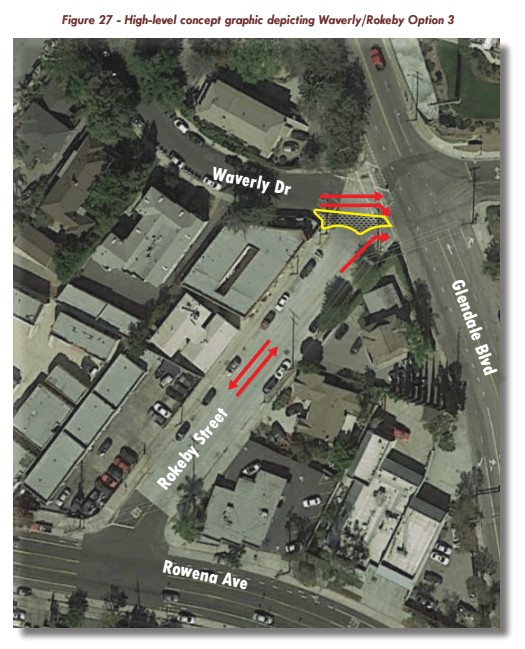L.A. City Councilmember David Ryu is working with the Silver Lake community to shape proposals to improve street safety. Ryu states that, in this process, "public safety is my top priority."
The improvements center on Rowena Avenue. Though it has made the street measurably safer, Rowena Avenue's half-mile road diet has been criticized by a handful of vocal naysayers. Many Silver Lake neighbors and stakeholders - under the banner of Keep Rowena Safe - support the diet and are pushing for further safety improvements. Ryu commissioned consultants Kimley Horn to do a traffic engineering study that appeared to make the case for undoing the Rowena road diet. At Ryu's direction, the L.A. City Transportation Department (LADOT) reviewed the Kimley Horn study and recommended retaining the road diet, calming nearby streets, and upgrading Rowena's bike lanes.
Councilmember Ryu responded to the study and review by seeking further community input. Last night, Ryu hosted an open house meeting. Ryu is currently requesting Silver Lake stakeholders complete a survey.

Last night's open house was attended by about a hundred individuals. Keep Rowena Safe folks, including many bicyclists, appeared to have turned out in fairly large numbers.
The meeting was an open house format. There was no broad public discussion, nor even a presentation - so it is difficult to decisively reach any overall conclusions. Attendees were requested to fill out paper versions of the online survey, as well as to post ideas on map boards.

Much of the focus appears to be shifting away from Rowena Avenue itself. The new priority appears to be mainly dealing with car traffic on smaller parallel streets, especially Waverly Drive to the north and Angus Street to the south.
Road diet critics and many local residents (and even Ryu) are quick to blame Waze for so-called "cut-through traffic," though they have shown limited support for effective low-cost traffic-calming solutions. Nearby, in the eastern portion of Silver Lake represented by Councilmember Mitch O'Farrell, LADOT implemented very effective safety fixes for Baxter Street, which cost less than Ryu's $88,000 Kimley Horn study. Similar measures on Angus and Waverly had been proposed by LADOT, but blocked by Rowena road diet opponents.
Proposed Waverly Drive safety improvements focus primarily at the five-way intersection of Waverly, Glendale Boulevard, and Rokeby Street - the site of a deadly hit-and-run car crash last September.

Kimley Horn proposed partially closing the northern end of Rokeby, as well as re-configuring some of that street's parking and sidewalks.

For Angus Street, Kimley Horn proposed converting one block - from Kenilworth Avenue to Moreno Drive - to a one-way street. Kimley Horn recommends that this project include adding one new sidewalk and eliminating parking in order to narrow the roadway to a single lane. A quicker pilot version could be done with plastic bollards. LADOT representatives stated that this change would require petitions signed by a super-majority of Angus residents. A less effective and less invasive alternative proposed would be adding some peak-hour turn restrictions.
For Rowena Avenue itself, LADOT and Kimley Horn recommended additional pedestrian lighting and bulb-outs. LADOT recommended upgrading the existing basic bike lane to either buffered or protected, either of which could be done without removing existing car lanes.
Ryu's survey closes on May 15. The council office should announce plans for the area some time after that.
Low-cost solutions (involving mainly just paint, bollards, signage - similar to Baxter Street) could follow fairly quickly. For more expensive components (new sidewalks, bulb-outs, lighting), the improvements would likely be years off, as LADOT would need to seek outside grant funding.







